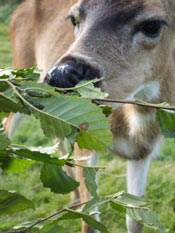Now is the time for All-Season Deer Repellent
Winter is almost upon us, and with it, less tender vegetation for deer to eat. In northern climes, leftover grain from harvests will soon be covered with snow. What does that mean for avid gardeners? All but your most prickly, foul tasting (at least, for deer), trees and shrubs become targets for hungry pests. If you are unlucky, like William Alexandar, author of The $64 Tomato, you have a neighbor who thinks it is fun to feed the deer. The deer snack on whatever your neighbor has to offer, and then the deer come snack on your shrubs. There are some ways to stop neighborhood (regional?) deer from viewing your yard as an all-you-can-eat buffet. Your level of dedication, financial situation and aesthetic sensitivity will help you make your decision.

Keeping Deer at Bay: Tips for Success
There are several things you can do to keep deer away from your garden plants. For the most part, your options fall into two categories: repellents and barriers. Repellents are anything that functions as a deterrent for the deer. This could include repellent sprays, motion-activated deer alarms and other tips. Barriers are physical blocks that keep deer from even reaching your plants. There are several different forms of repelling tools and barrier tools for keeping deer at bay.
Repellent Sprays
Well-made, environmentally friendly repellent sprays are one of the most cost-effective and aesthetically pleasing ways to deter deer from your yard. There are many sources for deer repellent sprays, but most are so unpleasant to smell not only will deer not enjoy being in your garden, neither will you! Luckily, repellents from I Must Garden are highly effective, and pleasant to use.
Pros of Repellent Sprays
- Deer repellent sprays are easy to apply
- Deer repellent sprays are aesthetically pleasing, because you can't see them. (You have to get a repellent that smells bad to the deer, not to you. Otherwise you lose the "aesthetically appealing" part.)
- Deer repellents from the right sources are environmentally friendly. (I Must Garden's repellents are made entirely from natural, biodegradable materials. The containers in which they come are recyclable.) Deer netting, on the other hand, is not recyclable, and if discarded improperly can be ingested by animals, or worse, catch animals in the net.
- Deer repellent sprays are cost-effective. I Must Garden's Repellents are long-lasting and withstand the rain.
"I've tried everything! Made many concoctions myself too but I have to say I Must Garden Spice Scent is the best sauce I've ever used. Easy to use (so much easier than the stuff I made, YUK!) and it seems to last a month or so. Thank you, THANK YOU!
Dogs
Deer are frightened by dogs because they are highly unpredictable. If you have the luxury of keeping a dog for working purposes, a dog in the yard is a great way to scare away deer. The problem with using a dog to repel deer is that the dog basically has to be outside at all times for this to work. This might be great for your garden, but not so great for your dog. Unless you literally have a pack of dogs that can roam together, the dogs will get lonely and misbehave. (Potentially tearing up your garden!)
Ultrasonic or Motion Activated Scare Devices
There are a variety of ultrasonic devices that you can place in your garden to emit an audio frequency that you cannot hear, but deer can hear, and they don't like it. These will work for a while, but eventually the deer, especially if they are hungry, will get used to the noise, and it will not bother them anymore.
In this category, as well, are motion-activated disturbances like a fake owl that starts making noise when a deer crosses its path. Some people use motion activated radios, too. Any of these will work for a while, but eventually the deer will get used to them, too, and these devices will lose their effectiveness.
Barriers
You can elect to use a barrier to deter deer. If you put up a fence, it has to be at least ten feet tall. I recently priced 120 linear feet of six foot tall fence and it was unbelievably expensive. I can only imagine what ten-foot-tall fence would cost. Another type of barrier is deer netting. You drape deer netting right on top of your trees and shrubs you would like to keep the deer from eating. The problem with netting is that, unless the plant is a very dense, dark evergreen, you can still see the netting. Additionally, because the netting is directly on top of the plant, deer can still nibble a bit on the plant.
Why Put out Repellent Now?
Deer repellents are really the most cost-effective, and effective way to keep deer from eating your plants this winter. If you value your arborvitae , you need to protect them, especially in the winter when few other food sources for deer make them hungry and willing to eat almost anything. Have you ever driven through a neighborhood and it looks like someone used an out of control chainsaw to prune their shrubs--from the bottom, up? That would be deer damage, and it isn't pretty. Your yews, viburnum, euonymus, hydrangeas, and roses are also tasty snacks. If deer munch your beloved shrubs to the ground during the winter, they won't look so good come spring, and could have a hard time bouncing back.
Now, before it is too late, apply your I Must Garden Deer Repellent so that you have plants, and not deer-stripped twigs, in your yard this winter.

